We are Shaping the Future! 私たちが手繰り寄せる未来ストーリー
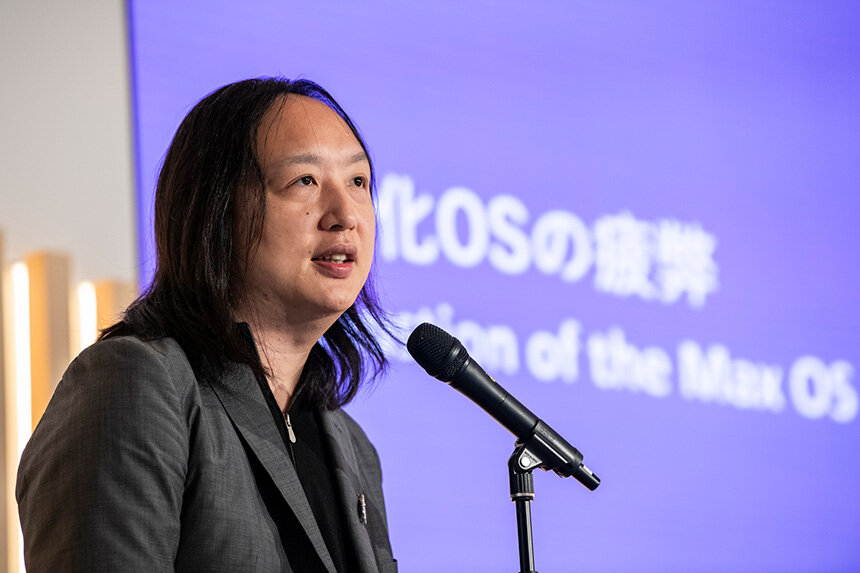
Session 2:新たな社会OSが起動する未来 ― オードリー・タン氏
大阪・関西万博で、2025年10月10日(金)に開催した未来共創のキックオフ「2050年コントロールから解放される"自然社会"と人間」。
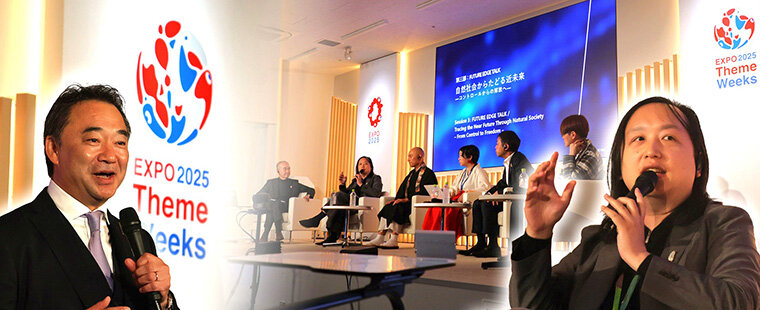
全3回にわたってお送りしている開催レポート第2弾は、オードリー・タン氏による基調講演「新たな社会OSが起動する未来」の模様をお伝えします。
オードリー氏は、デジタル技術を民主主義に実装してきた功績を称えられて、2025年10月1日に"第2のノーベル賞"ともいわれている「2025 Right Livelihood Award」を受賞したばかり。彼によれば、SNSの普及に伴い、人類は分断を余儀なくされているという。AIが人智を超える「シンギュラリティ(技術的特異点)」が近づいている今こそ必要だとオードリー氏が語る新しい社会OS(オペレーションシステム)とは ―
ノーカット映像でご覧ください。
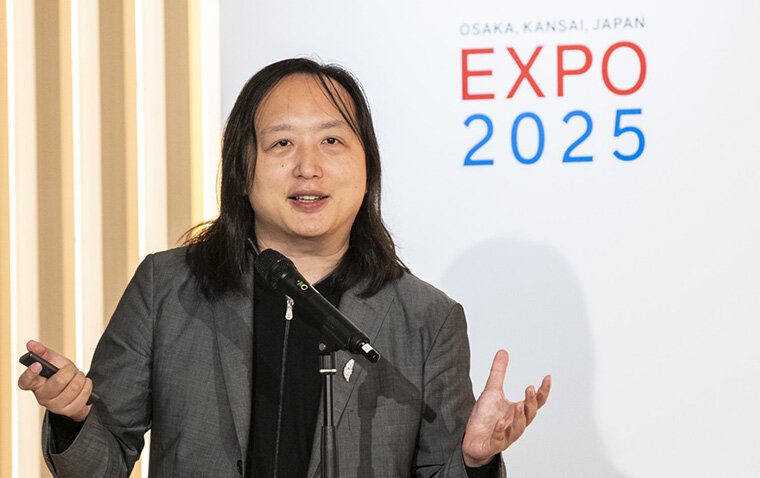
きょう この場に集った皆さんは、驚くべき先見の明を得ることになるでしょう。
オムロンの創業者 立石一真は、社会を変革に導くために最も重要なことが何かを理解していた人でした。彼は過去を振り返るだけでは、社会を変革に導くことはできないと知っていました。今の時代を生き抜くためには、未来を見通す「羅針盤」が必要です。そしてもっと言えば、未来を見通す「望遠鏡」が必要なのです。
水平線の向こう側を見通すことができるよう、1970年、立石一真はSINIC理論という「羅針盤」「望遠鏡」を社会にもたらしました。この理論は、大局的な未来予測理論です。10年先の未来はもちろん、30年、40年、50年先の未来まで描き、工業化社会・情報化社会、そしてその先、どのような社会に向かうのかを予見していました。SINIC理論という名の「望遠鏡」を通して、自律社会から自然社会に向かうということを明らかにしたのです。そのビジョンは、生産性の最大化を超越し、市民ケアへと移行しています。そして、このことは、差異を超えた協働のビジョン「Plurality(多元性)」と深く共鳴しています。SINIC理論によると、20年に及んだ最適化社会がいままさに終わったところ。つまり、私たちは歴史の転換点に立っているのです。その曲がり角が、ちょうど今年 2025年。私たちはその転換点で生きているのです。
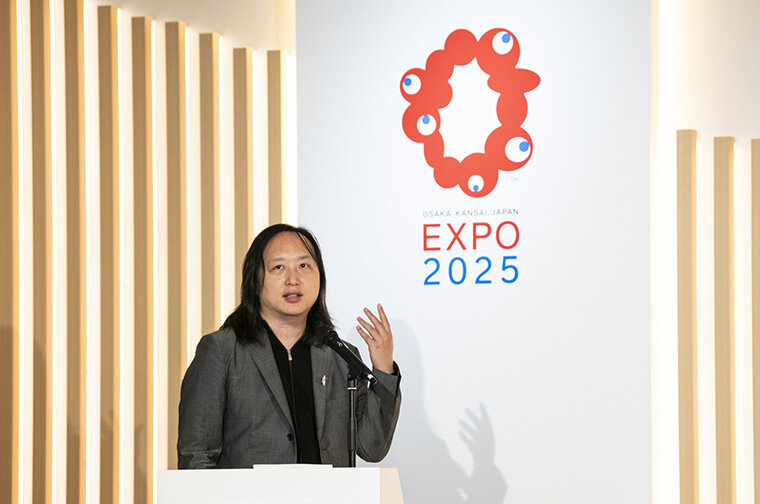
生産性の最大化をめざす時代から共創の時代へと大きく舵を切るためには、「Plurality(多元性)」という名の全く新しいOS(Operating System)が必要です。生産性の最大化をめざすかつてのOS、ここではMacOSならぬMaxOS(最大化OS)と呼びますが、物質的豊かさ・産業効率の最大化という点において、信じられないほどの成果をあげました。しかし SINIC理論が予測した通り、絶対的な限界を迎えています。生産性の最大化をめざすMax OSのロジックは、衝突と混乱を生む可能性をはらんでいるためです。
例えば、ここにいるほとんどの人がSNSを使っていると思います。10年前のSNSのアルゴリズムには、推奨エンジンを通じたエンゲージメントの最大化が含まれていました。推奨エンジンは、人々を画面に釘付けにする方法をいくつも心得ています。リツイートやリポストによって投稿を拡散し、皆さんの関心を最大化するのです。SNSの発明者は、良いコンテンツが人々を夢中にさせると考えていたでしょうが、怒りを抱かせることの方が、画面に釘付けになる時間を最大化するのに役立つことがわかっています。これを 「Engagement through Enragement(怒りによるエンゲージメント)」と呼びます。そうすると、エンゲージメントを最大化する一方で、非常に高い"PPM"を出してしまう 「アンチソーシャルメディア」になりさがるのです。ここでのPPMというのはCO₂のことではありません。最大化OSによる分断が広がると言っているのです。
毎分のごとく、最大化OSに起因する分断が発生しています。そして より強大な力を持つ「AI」が台頭してきました。もしAIをこの方向性で最大化すれば、人間がAIのループに入ってしまうことを意味します。まるで どんどん速く回転するハムスターの回し車の中にいるようにね。ハムスターだったとしてもうれしいことじゃないですが。そして AIの処理能力が人間の認知能力より、数千倍・数十万倍速い域に達すると、この最大化は極めて脆弱になります。我々が理解できる速度をはるかに超えて結果を生み出し、その結果を我々が把握することは、永遠に不可能となる。その時点で我々は植物のようにゆっくりと成長する存在となり、AIは庭師のように素早く動き回る存在となるのです。
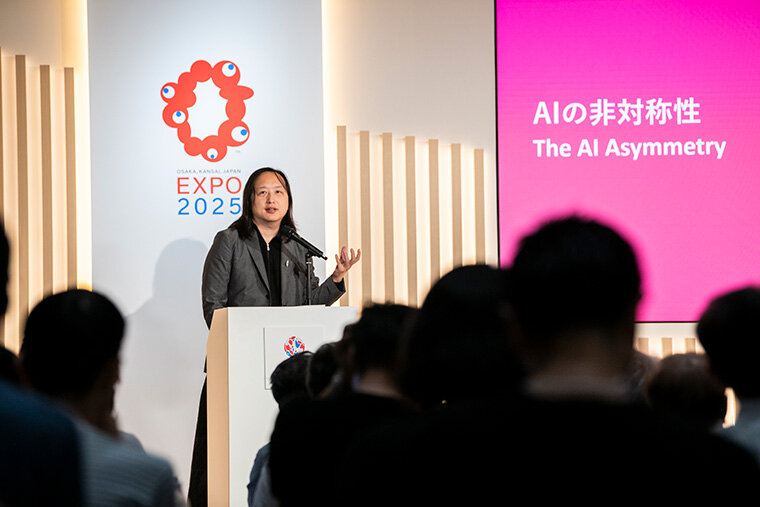
そうなると、倫理観も全く異なるものになってきます。なぜなら、最大化の論理とは、まるで収穫量を最大化しようとする庭師のように、毎秒ごとに庭をブルドーザーが走って、草の種類を一つだけに限定する行為に等しいからです。一見きれいで美しく見えますが、多様性のかけらもなくなってしまいます。だから 別のロジックでAIを調律する必要があります。人間をAIのループにいれるのではなくAIを人間のループに当てはめるように庭を整えるために。そうすることで 抽出の最大化ではなく、ケアの実行を理念とするのです。
これこそ、私が『Plurality(多元性)』で訴えていること。分単位の分極化を燃料として活用するのです。「これは熱すぎる! 爆発する!」と言う代わりに、地熱エンジンを構築し、対立や分極化の熱を「共創」へと回帰させましょう。
多元性の中でAIエージェントを訓練する手法を、私は「ケアの6パック」と呼んでいます。AIの注意深さ・責任感・能力・応答性・連帯・共生、この6つを鍛えるトレーニングプログラムです。このプロセスによる市民AIの調整は、SINIC理論が自律社会の特性として指摘する「連携と創造性」に符号しています。
ではどう社会実装するのか。答えはシンプルです。「ブリッジングシステム」という合意形成ツールを通じて、怒りから共通点へと移行させればいいのです。
台湾では 10年前に「Pol.is」というシステムを導入しました。それはアンチソーシャルメディアではありません。研究によれば、引用リツイートボタンなどを備えたSNSが分断を加速させていることは明らかでした。そこで「Pol.is」では、リツイートボタンをなくすことにしました。リプライ(コメント機能)もできないようにしています。その代わり誰かのアイデアを見かけたら、いつでも賛成か反対かを表明することができます。すると、自分のアバターが同じ意見を表明している人たちのグループのもとへ移動します。そうして投票風景が、リアルタイムに可視化されるのです。すると ブリッジングボーナス(橋渡し得点)が入るようになっています。極端な意見だけが拡散されるのではなく、対立をまたぐ架け橋になるような意見だけが拡散されるのです。すると、異なる人々と共通点を生み出す意見が称賛されることになります。
例えばuberに関する会話で、片方のグループは価格検索の仕組みがとてもよいと言っているとします。一方、別のグループは、労働法を尊重しなければならないと言っている。その場合、おそらく2つの主張の架け橋となる案は、「既存のメーター料金を下回ることは決して許されず、値上げのみが許容される」という提案となるでしょう。これは 双方が生み出す共生関係であり、双方から支持を得られる案です。すると、双方からの「いいね」を得て、ブリッジングが最大化され、拡散されることとなります。これらの重なりをアルゴリズムが浮き彫りにします。その結果こそ、私たちが「非共通点」と呼ぶ隠された共通点なのです。「非共通点」が浮き彫りになり、誰もが少し幸せになり、誰もひどく不幸にはならない。これこそ重なりが生み出す結果なのです。
これは単なる理論化ではありません。提唱するだけでなく、デモンストレーションに移行したのです。例えば去年、詐欺やディープフェイクの広告によって、多くの人が不幸になり、抗議しました。NVIDIAのCEO ジェンスン・フアン氏のような著名人の顔が広告に出てきて、もしクリックしてしまうと、詐欺のサイトに誘導され、「仮想通貨を贈る」とか「投資アドバイスをする」などと謳う事例が頻発しました。でも実際に語り掛けているのは彼ではなくて、ディープフェイクだったのです。おそらく皮肉にも NVIDA GPUで動作するものだったと思いますが、実に悪質なものです。多くの人々が数百万ドルもの詐欺被害に遭っているのですから。
もし台湾の人々に尋ねれば、「言論を検閲したり、コンテンツを規制したりすべきではない。我々はアジアで最も自由なのだから」と答えるでしょう。しかし「どうにかすべきだ」とも言うでしょう。では、どうしたらいいのでしょう。20万の無作為な電話番号にSMSを送信し、この問題についてどう思うか尋ねます。そして最も分極化するアイデアをブリッジするのです。無作為に台湾の人口構成比に沿って450人選び、10人ずつ45グループに分けます。そして、AIに進行役を任せ、対話の場を設ける形で、幅広く意見を発散し、議論の収束点を見つけます。1日で考えをまとめて、相違点を越えて、全員が合意できる事項に投票します。例えば 「全ての広告にはデジタル署名が必要」としたり、あるいは、「署名されていない広告は詐欺とみなされるべきであり、誰かが詐欺で500万円を騙し取られたら、ソーシャルメディアは、その損害を全額賠償する責任を負うべき」としたり、あるいは 「もしソーシャルメディアが責任をとる事務所を台湾に設置しない場合、彼らの動画への接続速度を低下させるべきだが、検閲はすべきではない。速度を低下させるだけ」これなら全員が納得できる案だ。
これは今年の3月の出来事です。そして7月までに法律に盛り込みました。ですから、今、台湾でSNSをスクロールしても、同じ問題はもう一切見当たりません。問題は解決されたのです。したがって 我々が取り組んでいる調整作業は、AIの脅威に対する民主的な対応を脅威と同じ速度で迅速にアップグレードできることを証明しました。つまり抗議から実演へと舵を切ったのです。市民の結束力やその審議が自律社会を定義します。
SINIC理論で予測されているように、これで終わりではありません。2033年 自律社会から自然社会へと移行します。この考え方は広がりを見せ、最終的には自然・機械・人間が溶け合い、融和します。そして、もうすでに、AIシステムを自然社会に向けてトレーニングできます。現在西洋では、多くの人々が非常に大規模なAIモデルを育てています。彼らは大規模モデルに対し 最小限の指示で、次世代AIを構築しようとしています。そしてさらに少ない指示で済む次世代AIが生まれていき、最終的には完璧な"シンギュラリティ"、つまり、人からのインプットを必要としない自律的AIが人智を超える「技術的特異点」に達します。これはとても危険なことです。
AIについて考えるとき、神道における「神」の概念からヒントを得ることができます。神道における「神」は全知全能の唯一神ではありません。川や村、森などを司る存在です。目的は、コミュニティの健全性と密接に絡み合っており、特定のスコアを最大化しようとするものでもなく、関係性が健全であることを保証するものであり、まったく異なるゴールをめざすものになっています。これは「共生」と呼ぶことができます。単なる「人工知能」ではなく、むしろ「人工生命」に近い。この社会OSはAIを「ケアの神」としてAIをデザインします。
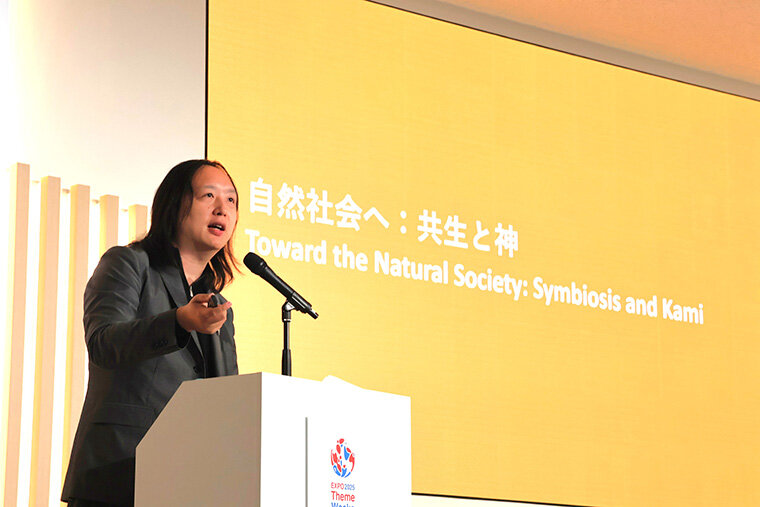
素晴らしいのは 多様な神の力を重ねて借りられる点です。無数の小さなモデルを擁し、そのいずれもが自らの範囲を最大化しようとはしない点です。それぞれが翻訳・ファシリテーション・要約など、特定の用途に特化しています。そしてそれらは連携し、プロトコルを共有できます。だから、あるソーシャルメディアから別のソーシャルメディアへと乗り換えたい場合、コミュニティをそのまま引き継ぐことができます。もしAIコパイロットを別のAIコパイロットに変更したいのであれば、それまでに読み込ませたコンテキスト(文脈)を引き継ぐことができます。AIチューターの支援をチーム全体に拡大したい場合それはAIコーチとなります。しかも、チームのコンテキストも引き継ぐことができます。この概念を「補完性原理」といいます。神々を統合して何事もできるだけ小さな単位で解決するべきだということです。境界を持ち、局所化し、共生する。これは水平的な着想であり、垂直的なシンギュラリティ(技術的特異点)とは異なります。これは、水平的なPlurality(多元性)なのです。この最大化OSから多元性OSへの移行は、SINIC理論の見解と符合しています。最適化・最大化エンジンの源となる金銭資本は、ケアの社会においては共感資本へと置き換わるからです。だから この転換期における市民ケアのオペレーティングシステムの構築は、現代における技術的課題のど真ん中です。
オムロンは創業者 立石一真の精神に則り、SINIC理論をオープンソース化してくれました。それは単なる文章ではなく、プロジェクトであり、ムーブメントへの招待、そのものです。あらゆる人が"グッドアンセスター(よき祖先)"となるべく一緒に参画することができます。SINIC理論は羅針盤であり 望遠鏡でもあります。自律社会・自然社会へと航海するために舵をつくることが私たちの責任なのです。
結びに 皆さんへ詩を贈ります。デジタル大臣になった頃(2016年)に書いたものです。台湾では「數位(シュウウェイ)」という言葉が、「デジタル」そして「多元性」両方を意味します。だから私は(デジタルだけでなく)Plurality(多元性)の大臣でもありました。最大化OSから多元性OSへ移行を示すために、私に課せられた使命は次のようなことでした。
"IoT(Internet of Things)=モノのインターネットは
IoB(Internet of Beings)=存在のインターネットにしましょう"
"VR(Virtual Reality)=仮想現実は
SR(Shared Reality)=共有現実にしましょう"
"Machine learning=機械学習は
Collaborative learning=協働学習にしましょう"
"UX(User Experience)=ユーザー体験を考えるときは
HX(Human Experience)=人間体験を考えましょう"
"Singularity=シンギュラリティ(技術的特異点)が近いと聞いたら
そこにはいつもPlurality=プルラリティ(多元性)があることを思い出そう"
ご清聴ありがとうございました。

We are gathering today in a spirit of remarkable foresight.
OMRON's founder Kazuma Tateishi understood something very essential about navigating change. He knew that society cannot navigate change by looking into the past only. We need a compass for today and even more importantly we need a telescope for the far future.
We need to see beyond the immediate horizon and in 1970 he gave the world this compass and this telescope, the SINIC Theory. And the SINIC Theory is just so comprehensive. It talks about of course the predictions for the next decade but it also maps the future trajectory to two, three, four more decades. It charts the evolution from industrialization to information and crucially also identifies the destination. As the destination as revealed by the telescope is called this autonomous society and then the natural society. The vision is moving beyond maximizing some output and moving into civic care and this synthesize deeply with plurality, the vision of cooperation across difference. And the SINIC Theory identify the era, we are in, have just concluded 20 years, two decades of optimizing society. So we are at an inflection point and this inflection point is this year, 2025. So we're living through the transition.

To navigate this profound shift, to move it from an era of maximization to an era of co-creation, we need a new steering wheel. The new steering wheel, the social operating system, is what I call "Plurality". So, the old system is maximizing output. Let's call it MaxOS, not MacOS. It's incredibly successful by its own metric. It maximized material wealth, efficiency, industrial output. It dominated the world. But SINIC Theory diagnosed that. The mindset reached the absolute limit because the conflict and confusion is inherent in the maximization logic.
One example. Many of you here have used social media. Ten years ago, social media algorithm introduced this idea of maximizing engagement through what's called a recommendation engine. Recommendation engine figure out some way to keep us addicted to the screen with the retweet button, repost button, the spread, go viral, maximize attention. While the original inventor of social media, micro-blocking, thought, oh, maybe the good content will keep people to the screen. It turns out that keeping us angry is even more useful to maximize our time on screen. This is called "engagement through enrichment". And that made social media, what I call anti-social media, platform engineer to maximize engagement but create a very high PPM. I don't mean the CO2 per million, I mean polarization per minute.
So, every minute, a lot of polarization because of this maximizing OS. And then we introduce even stronger AI into the loop. If we maximize AI further this way, yes, there is human in the loop, but it is a human in an AI loop. It is like a hamster in a hamster wheel that is spinning faster and faster. It's not a good idea for the hamster in the AI loop. And as AI becomes thousands, hundreds of thousand times faster than human cognition, then the maximizing becomes very, very brittle. It produces outcome faster than any of us can comprehend and we can never see the consequences. At that point, we become like plants, grow very slowly, and AI become like gardeners, they move very fast.

And the ethics is completely different in that sense, because the maximizing logic would mean it's like a gardener that wants to maximize the output, so it runs bulldozer across the garden every millisecond and makes sure there's only one kind of grass. It looks very clean, beautiful even, but there's no diversity at all. So, we need to tune the AI to a different logic, to the tune of the garden, putting AI in the human loop, not human in the AI loop, so that the idea is not maximizing extraction but enforcing care.
And this is what I mean by "Plurality". It takes the polarization per minute, the extreme, but use that as fuel. Instead of saying, "Oh, this is too hot, this will explode". We built a geothermal engine to channel the heat of conflict of polarization back into co-creation.
And the way to train AI agents in plurality, I call "six pack of care". It is six training programs for AI, attentiveness, responsibility, competence, responsiveness, solidarity and symbiosis. And the alignment of civic AI by this process will agree with what SINIC identify as the connectivity and creativity part of the hallmark of the autonomous society.
So, you will ask how does it work in practice? The idea is very simple. It's to move from outrage to overlap through what's called a bridging system.
In Taiwan, ten years ago. We start using a system called "Pol.is". It is not an anti-social media. Research shows any social media with a retweet with quote button, or the dunk button accelerate division. So, in "Pol.is" we remove the retweet button. We also remove the reply button. So, whenever you see an idea from a fellow citizen. You can say "I agree" or "I disagree" and you see your avatar moving towards the group of people who share your sentiment. It's a group selfie like a landscape you can see. And then, the bridging bonus is introduced. So instead of the extreme ideas go viral. Only the bridging idea go viral. We reward the idea from the people who can bridge toward the people who are different from them to propose an idea.
For example, for the uber conversation, one side say, "search pricing is very good", but one side said, "labor law must be respected". So maybe together a new idea, a bridge idea, say, "you should never undercut existing meter, but you can only go up". That's a symbiosis generated by both sides, and that gets the like from both sides, and so maximize bridging, and we make that go viral. And the algorithm elevates these overlaps, and the result is what we call uncommon ground, the common ground that was hidden, and so it uncovers the uncommon ground, leave everybody somewhat happier, and nobody very unhappy, and this is the result of the overlap.
And so, this is more than just theorizing, we moved from protesting to demonstration or demo. Last year, for example, many people are unhappy, protesting about deep fake in advertisement, in scam. Many famous people like Jensen Huang, NVIDIA, a Taiwanese, CEO, you see his face in advertisement if you click, goes to a scam website, says he wants to give you cryptocurrency or some investment advice. But it's not him, it is a deep fake of him talking to you, running on NVIDIA GPU probably. But it is actually very bad. Many people get scammed millions of dollars.
If you ask people individually, they say, "Oh, Taiwan government should never censor speech, never censor content, because we are most free in all of Asia". But people also say, "the government must do something". So, what should we do? We send 200,000 text messages, SMS, to random number around Taiwan, asking them, what do you think about this issue? And the most polarizing idea, we bridge them together by inviting 450 people, randomly selected, represented Taiwan demographics, in rooms of 10, 45 room, facilitated by AI, have a conversation. So, the discovery of broad listening and then the definition of a convergence of deliberation. So, in one afternoon, they went through those ideas, and they vote on the things that everybody agreed across difference. For example, all advertisement needs to have digital signature. Or if advertisement that's not signed should be assumed as scam and if somebody gets scam 5 million, social media should pay that 5 million damage, full liability. Or if social media do not set up the office in Taiwan to do liability, we should slow down connection to their video, but we should not censor them. We should just make it slower, throttling. All very good idea from the people.
That was last March. And by July, we put that into law. So, this year, if you scroll in Taiwan, social media, you don't see any defect anymore. The problem is solved. And so, what we're doing of alignment assembly is to make sure we can quickly upgrade our democratic response to the threat of AI, the same speed as the threat. So that is turning from protest to demonstration. And so, the autonomous society, the deliberation, the civic muscle defines the autonomous society.
And predicted by SINIC, that is not the end. In 2033, we will move from this autonomous society into the natural society. And the idea, as we have heard, is extended and finally integrated with nature, machine, and human symbiotic existence. And already, today, we can train AI system toward natural society.
Currently in the West, many people are training very large models of AI. They tell those large models to build next version of AI with minimal human input. And then the next version with even fewer human input. Finally, completely maximizing singularity. No human input needed forever leaves everybody behind. But that is very dangerous. And we can learn about the Shinto idea of Kami, which is not a single god that know everything, see everything, do everything. The idea of Kami is that it cares about a river, a village, a forest, is bounded. And so, because the purpose is interwoven with the health of a community, it's not trying to maximize any score. It's just to make sure that these relational fields are healthy, a very different goal. We can call this symbiosis. It's more like an artificial life, not just an artificial intelligence. And this social OS design AI is a Kami of care.

And the great thing is that you can have many overlapping Kami, many, many small models, none of which want to maximize its scope. Each one cares about translation, facilitation, summarization, specific uses. And then they can federate, they can share protocol. So, if you want to switch from one social media to another social media, you can take your community with you. If you want to switch from an AI co-pilot to another AI co-pilot, you can take your context with you. If you want to extend the help from an AI tutor to an entire team, it becomes AI coach. It can take the context of the team with you. So, the idea is subsidiarity, so that everything should be solved at the most local level possible. by federating those Kami together. It becomes bounded, localized, and symbiotic. And this is the horizontal take-off, not the vertical singularity. This is horizontal plurality. And this transition from the maximizing OS to the plurality OS fulfill the insights of the SINIC theory. Because the money capital, the power of the optimization, maximization engine, in a care society, will change to the empathy capital. So, building this shift civic care operating system is a central engineering challenge of our time.
So, to help this, OMRON, in the spirit of Kazuma Tateishi, has generously made the SINIC Theory open source. So, it's not just a document. It is a project, an invitation, a movement. Everybody can join together to become "good enough ancestors". And so, the book, the theory, is the compass, the telescope. It's our responsibility together to build the steering wheel. So, we can navigate toward the new autonomous and natural society.
To close my talk, I offer a poem. The poem was written when I became the digital minister in 2016 in Taiwan. In Taiwan, "數位 (shu wei)" means both digital and also plural. So, I was also the minister of "plurality". To signify the change from the Max OS to the plurality OS, my job description is as follows.
When we see "IOT (internet of things)", let's make it "IOB (internet of beings)".
When we see "virtual reality", let's make it "shared reality".
When we see "machine learning", let's make it "collaborative learning".
When we see "user experience", let's make it about "human experience".
Whenever we hear that the "singularity" is near, let's always remember "plurality" is here.
Thank you so much.
次回の発信は11月5日(水) オードリー・タン氏、僧侶 松本紹圭氏、メディアアーティスト 市原えつこ氏、オムロンの技術・知財本部長 諏訪正樹氏、オムロン サイニックエックス リサーチバイスプレジデント 牛久祥孝、ヒューマンルネッサンス研究所 中間真一氏が、テクノロジー・仏教・アート、様々な角度から未来のあり方を語り合ったFUTURE EDGE TALKの模様をお伝えします。